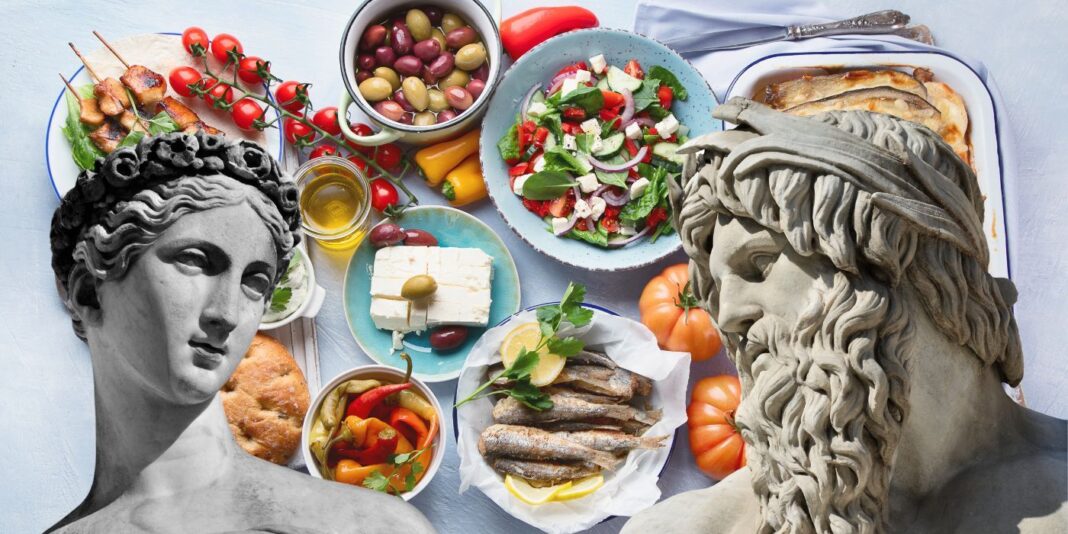Greek cuisine:

It’s easy to plan a family vacation in Greek: in the morning and afternoon – the beach, in the hot hours – sleep, and in the afternoon and evening – a meal in a tavern and an attempt to decide which national dish of Greek is the most delicious. Children can also take part in the discussions, since the traditional cuisine of this country is suitable for children’s stomachs.
The specifics of Greek cuisine:

The cuisine of Greek has absorbed all the traditions of Mediterranean cooking: it generously uses fresh vegetables, herbs, olive oil, and seafood. The cooking methods that the Greeks prefer make the food healthy and nutritious, which is so important for children’s nutrition. Greek cuisine also has its own secrets, thanks to which simple, simple dishes have a special taste.
– The first secret of the national cuisine of Greek is in the set of herbs and spices. Garlic, onion, bay leaf, oregano, thyme, basil, thyme, dill, mint, nutmeg, cinnamon, cloves – this is not a complete list.
– The second secret is vegetables and legumes warmed by the Greek sun: tomatoes, peppers, eggplants, zucchini, green beans, chickpeas.
– The third is the frequent use of cheeses made from sheep and goat milk in dishes: feta, manouri, halloumi, kefalotyri, caseri and others.
– Fourth – the widespread use of goat and lamb in the preparation of meat dishes; pork, beef and poultry are also used.
– Fifth – love for fresh fish and seafood dishes.
– Sixth – methods of processing products that preserve maximum nutritional properties. Baking is most often used; There are also many boiled and stewed dishes.
– And the last of the secrets is the reverent attitude of the Greeks towards olive oil.
The oil is often pressed independently, by hand, and its taste depends not only on the method of preparation, but even on the region where the olives grew. In Greek, only olive oil is used for frying food. To taste traditional Greek dishes, it is worth avoiding tourist-oriented establishments with local dishes. Real Greek cuisine is found in those taverns where Greeks and their families gather in the evenings to have a hearty dinner and socialize.
In Greek, only olive oil is used for frying food.
To taste traditional Greek dishes, it is worth avoiding tourist-oriented establishments with local dishes. Real Greek cuisine is found in those taverns where Greeks and their families gather in the evenings to have a hearty dinner and socialize.
National dishes of Greek:

Let’s begin to praise the national food of Greek not with meat, fish or vegetables, but with the marvelous Greek olives. Large and dark fruits of the “Kalamon” variety, small green “Chalkidiki” with an oily sheen, dried olives from the island of Thassos – the Greeks grow their own olives and salt and marinate them themselves. Each tavern has its own recipes and secret knowledge about what herbs to put in the marinade and what to put in fruits instead of seeds.
Yogurt is the number 2 national food product in Greek. It is made from cow’s, and more often from sheep’s, milk. Greek yogurt has a thick consistency and is similar to soft cheese. It is added to salads and baked goods, used in stewing and baking, and ice cream is made from it.
Often yogurt, drizzled with honey or fruit syrup, is served as a dessert. By the way, you can make the same healthy sweetness yourself from soft anfotiro cheese, which resembles homemade cottage cheese.
Well, now we’ll tell you about the most popular dishes that are prepared everywhere in Greek:

- Moussaka is a casserole of eggplant with meat, usually lamb, with béchamel sauce.
- Stifado is a stew of meat in a thick onion sauce. Kleftiko is lamb cooked in a clay pot.
- Pastitsio is a pasta casserole with meat, cheese and egg.
- Paputsakya – eggplants stuffed with meat.
- Gemista – peppers or tomatoes stuffed with minced meat.
- Lukanika khorjatika – homemade sausages, to which, in addition to meat, various other products are added.
- Unusual additions include oranges or olives.
- Souvlaki are small kebabs on wooden skewers.
- Pites are puff pastry pies with different fillings: with cheese and spinach (spanakopita), with meat (creatopita), with cheese (tiropita).
- On Christmas Day, a special sweet pie called vasilopita is prepared.
- Dolma – cabbage rolls in grape leaves.
The full list of dishes would be much longer, but we have selected those dishes that are suitable for baby food. When deciding what to try from Greek cuisine, consider the peculiarities of preparing different dishes. Offer your children boiled, stewed, baked foods, and try to avoid fried foods.
How to whet your appetite:
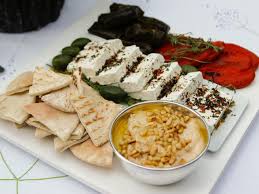
A typical Greek meal begins with appetizers, which in Greek are called meze. This concept includes light vegetable dishes. Here are just a few of the most popular snacks.
A typical Greek meal begins with appetizers, which in Greek are called meze. This concept includes light vegetable dishes.
Here are just a few of the most popular snacks.
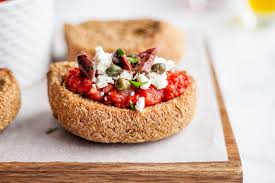
- Dzadzyki is a sauce made from yogurt with garlic and grated cucumber, which can be spread on bread or paired with crispy scordopsomo croutons.
- Melizanosalata – baked eggplant caviar.
- Dolmadakya – grape leaves rolled up in an envelope and prepared in a special way.
- Hummus is a soft chickpea puree with butter and spices. Keftedes – meatballs made from zucchini, tomatoes, eggplant, and mushrooms.
All this is incredibly tasty, but it’s still just a warm-up before the main course. We don’t recommend loading up on appetizers, because a large portion of the main course awaits you.
If you are not too hungry or are eating with a child, you can order one serving for two or three people. And if you’re really hungry, order different dishes for everyone so you can try a little bit of everything.”
Greek salads:
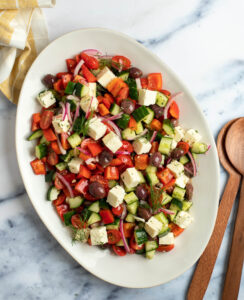
Salads in Greek are also a type of snack. But sometimes such an appetizer can replace lunch, since salads, in addition to vegetables, often include cheese (feta, mizifra).
The famous Greek salad (in Greek they call it “country” – khoriatiki salata), you must try: firstly, these are fresh vegetables, secondly, tender feta cheese soaked in tomato juice, coarsely chopped sweet onions, elastic oily olives – it’s simple extraordinarily tasty.
Dakos is a popular salad in Crete.
It is made from finely chopped tomatoes and myzithra cheese, seasoned with olive oil, oregano and basil. Dakos is served on a piece of toasted bread.
Angurodomata is a salad for picky children.
It consists of tomatoes, cucumbers and sweet red onions. There are no unfamiliar seasonings or cheeses in it.
Horta is a traditional dish in Greek.
It is prepared from young leaves of dandelion and chicory. The dressing is olive oil and lemon.
Fish and seafood dishes:

It is best to order fish dishes in taverns on the coast – this guarantees the freshness of the product. In such places, it is customary for the visitor to choose the fish and seafood for the dish. The simplest cooking method is roasting over coals, but there are a huge number of recipes. To help you navigate the menu, here are the names of the most popular dishes:
- htapodi sharas – grilled octopus tentacles;
- kalamarya yemista me tiri – baked squid;
- Midya akhnista – steamed mussels.
Dishes kids should try:

What to offer your child from nutritious food? First of all, of course, delicious moussaka. For lovers of homemade cutlets, order the aromatic meatballs keftedes or suzukakia, which are perfectly served as a side dish with baked vegetables.
Stifado or kokinisto stew is combined with potatoes or rice, and is often served with boiled carrots or broccoli. A child who prefers pasta will be happy to receive a portion of pastitsio for lunch. And the simplest meat dish that can be eaten without the help of cutlery is souvlaki kebab.
But if the child doesn’t turn his nose at the word “soup” (and even more so if he does), offer him some of the first courses. Avgolemono – a soup cooked in chicken broth with the addition of small orzo pasta in the form of rice grains – is light and nutritious.
Translated from Greek, this name means “egg and lemon.” Fasolada is a thick bean soup with tomato sauce. Fakes lentil stew is also very popular in Greek, but it is rarely prepared in taverns – you can try this when visiting local residents.
If you are having a meal with a child who has just begun to join the adult table, the tavern will not refuse to prepare simple dishes for the little guest – boiled meat, fish, vegetables.
As for vegetable dishes, children can be offered briam – a stew made from potatoes, zucchini, bell peppers and other vegetables. Also try bamies with your child, a dish made from stewed okra pods.
This plant is rich in vitamins and minerals; eating its fruits is a good prevention of digestive problems.
Dessert:

For desserts, any child will certainly leave room in their stomach. Many sweets in Greek are made using nuts and honey:
- melomakarona – sweet cookies with honey;
- loukoumades – donuts drizzled with honey;
- baklava – puff pastry with nuts.
Turkish delight (a jelly-like sweet made from starch and sugar with the addition of various flavors) will also delight the soul of a sweet tooth. Different regions have their own baking recipes.
For example, on Kos they bake cathimeria bagels, which are topped with honey syrup.
The highlight of Rhodes is the xerotigan bun in the shape of a rose. And in Zakynthos they make almond nougat mandolato.
A wonderful alternative to baking will be fragrant Greek fruits – apricots, peaches, strawberries, cherries, figs, grapes, melons and watermelons. Interestingly, the Greeks love to snack on watermelon with halloumi cheese.
Beverages:
As we are used to, people hardly drink tea in Greek – here it is considered a medicinal drink. The Greeks prefer coffee, especially frappe – chilled coffee with foam. You’ll be served a bottle of water with every meal, and kids can drink freshly squeezed orange juice (the unsightly Greek oranges used to make it are actually quite tasty).
Where to try Greek dishes:

National Greek dishes are served in hotels and restaurants. But to appreciate the nuances, it’s best to go to a tavern.
There is not necessarily the inscription TAVERNA above it – often the sign says RESTAURANT. You will recognize a real tavern by looking inside and seeing a simple interior, a minimum of service staff and a maximum of local residents at the tables.
It is important to note that you can eat in taverns without fear – the owners, who welcome guests as their friends, are very careful about the quality of the food.
What children will certainly like in Greek taverns is the lack of strict etiquette. Here you won’t get lost in forks and knives – there is a minimum of cutlery, and in some places some dishes are laid out directly on the table covered with clean paper.
This kind of little hooliganism, when the table serves as a plate, will be appreciated by the children and will awaken the appetite.
Note that taverns can have specialization. The best dishes of Greek, prepared from fish and seafood, will be served in coastal psarotaverns. The hasapotavern menu consists almost entirely of meat dishes.
And establishments called Girodiko and Souvladzidiko are considered fast food restaurants, and they serve the most traditional Greek food: souvlaki kebabs and gyros wrapped in pita, reminiscent of shawarma.
Whatever the name of the tavern, there will definitely not be desserts on its menu. You can drink coffee, which is revered in Greek, at Kaphenia, eat a pie at Tiropitadiko, taste Greek sweets at Zacharoplastio, and enjoy a dairy dessert at Galaktopolio.
In General:
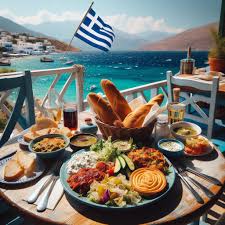
Multi-colored vegetables and juicy greens, olives, feta cheese and olive oil are recognizable features of Greek cuisine. In Greek, you will be offered dishes created at the crossroads of cultures, absorbing Mediterranean, Balkan, and Eastern traditions. And at the same time, Greek cuisine is unique and distinctive.
To feel the flavor of the national menu, in Greek you should order moussaka made of eggplants, tomatoes and juicy minced meat, meat stew stifado (it is cooked in wine sauce flavored with cinnamon), pastitsio casserole, lamb chops called paidakia, sausages- spetsofai with bell pepper. And also – be sure to find out how the real Greek salad differs from its variations.
Those with a sweet tooth should try baklava and custard puffs – galaktoboureko. Judging by the ratings and reviews, these pastries are among the most delicious desserts on the planet.
In conclusion.
All that remains is to wish: “Kali oreksi!”, which means “Bon appetit!”
